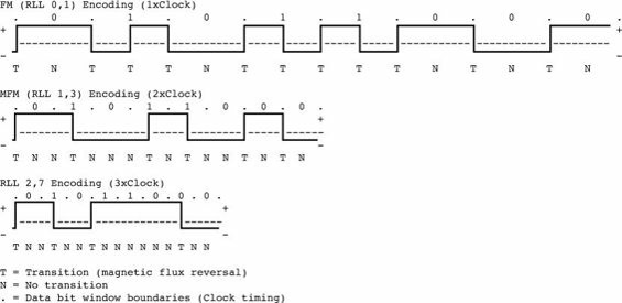Hardware Reference
In-Depth Information
store an “X” on the same media.
Figure 8.10. ASCII character X write waveforms using FM, MFM, and RLL 2,7 encoding.
Frequency Modulation Encoding
One of the earliest techniques for encoding data for magnetic storage is called Frequency Modulation
encoding. This encoding scheme—sometimes called Single-Density encoding—was used in the
earliest floppy disk drives installed in PC systems. The original Osborne portable computer, for
example, used these single-density floppy disk drives, which stored about 80KB of data on a single
disk. Although it was popular until the late 1970s, FM encoding is no longer used.
Modified FM Encoding
Modified Frequency Modulation encoding was devised to reduce the number of flux reversals used in
the original FM encoding scheme and, thus, to pack more data onto the disk. MFM encoding
minimizes the use of clock transitions, leaving more room for the data. It records clock transitions
only when a stored 0 bit is preceded by another 0 bit; in all other cases, a clock transition is not
required. Because MFM minimizes the use of clock transitions, it can double the clock frequency
used by FM encoding, which enables it to store twice as many data bits in the same number of flux
transitions.
Because MFM encoding writes twice as many data bits by using the same number of flux reversals as
FM, the clock speed of the data is doubled and the drive actually sees the same number of total flux
reversals as with FM. This means a drive using MFM encoding reads and writes data at twice the
speed of FM, even though the drive sees the flux reversals arriving at the same frequency as in FM.
Because it is twice as efficient as FM encoding, MFM encoding also has been called double-density
recording. MFM is used in virtually all PC floppy disk drives today and was used in nearly all PC
hard disks for a number of years. Today, virtually all hard disks use variations of RLL encoding,
which provides even greater efficiency than MFM.
Table 8.2
shows the data bit-to-flux reversal translation in MFM encoding.
Table 8.2. MFM Data-to-Flux Transition Encoding


